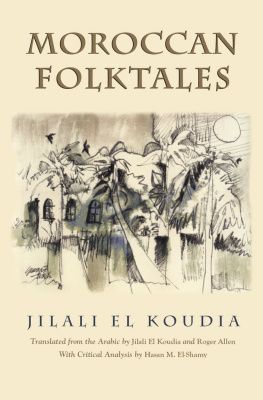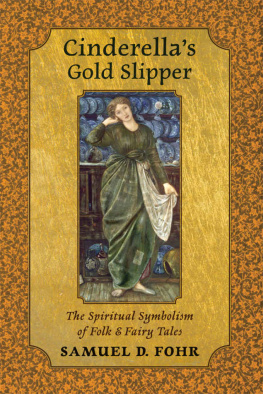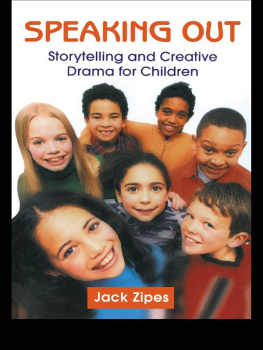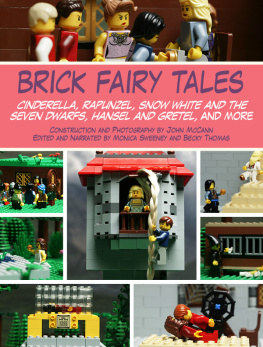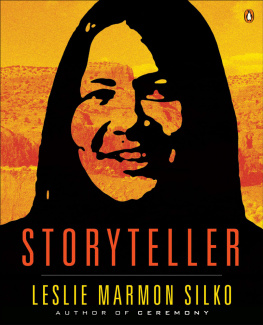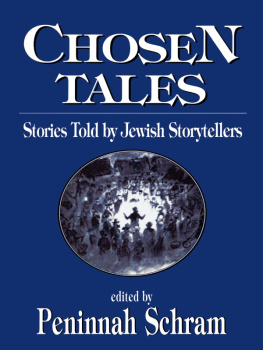Table of Contents
Guide
Page List
Acknowledgments
I AM DEEPLY GRATEFUL to Professor Roger Allen for his moral support and his tremendous contribution.
Professor Allen and I would like to express our thanks to Professor Hasan El-Shamy for writing the afterword and providing the categorization of the folktales, and to Professors Deborah Kapchan and Dan Ben-Amos for their assistance in bringing this project to fruition.
My sincere thanks are also due to my narrators, in particular my mother, Tahra; my sister, Sofia; my wife, Mehdia; her mother, Hadja Oum Keltoum, Rokia; my niece, Nadia; my student Belaali Chakir; Amina Ait Belarbi; and Malika and her women friends.
May 2003
Jilali El Koudia
Afterword
HASAN M. EL-SHAMY
The Present Work
THE SIGNIFICANCE of Professor Jilali El Koudias anthology of tales is twofold: it is the product of the creative work of two prominent scholars of Arabic literature and it appears in an established series published by a university press with a proven track record for excellence.
The anthology contains thirty-four independent units, all of which are reconstituted and rewritten by El Koudia on the basis of oral renditions of folktales from several of the women in his family. Consequently, the work could be titled Tales Moroccan Women Told Me or Tales I Learned from Moroccan Women.
Noting the rapid disappearance of oral folk narratives from the Moroccan scene, El Koudia states that [t]he idea behind this book stems from the awareness of this situation and the intention to preserve such lore, hoping that other similar attempts will follow suit. The urgent step to be made is to collect some of these tales, the raw material itself, in order to make them available to future generations.
El Koudia describes the process involved in his re-creation of the texts: I had to make a selection, discarding repetitions. In fact, the work I have done is more of rewriting, reconstructing the plots, and filling the gaps than just translation. This is because most of my narrators were wordy, repetitive, and kept going back and forth trying to recall the stories from memory.
Available Tale Collections
Morocco has a unique cultural status, with its ethnically and linguistically diverse population; its historical position of leadership in such spheres as politics, arts, and religious movements; its role as a bridge between the Arab-Islamic world and Christian Europe and Muslim Spain (or al-Andalus); and its contacts with sub-Saharan Africa. Interest in Moroccan oral traditional narrative followed the same course as its counterparts in other regions of the Arab world. Apart from narratives that entered classical Arabic literature as part of secondary religious and language sources, interest in the true folktale among the elite was virtually nonexistent. Maghribian traditional cultures and societies have received remarkable attention, primarily from French scholars and their native associates and others with varied religious and political objectives (such as missionaries and colonial administrators with special interests in Berber communities and culture). Their endeavors yielded a rich crop of narrative collections of varying quality, ranging from the scientifically precise to the loosely re-created,
On the Tales Genres
Numerous Maghribian tale collections were presented in terms of their literary genres. However, owing to the fact that the tale texts in El Koudias anthology are re-creations, and that contextual and performance data are not provided (e.g., a narrative is not attributed to a specific narrator, there are no stylized beginnings or endings, or the time and place of narration is not given), the genres of the tales must be inferred primarily on the basis of their content and in light of other versions of the tale in relevant tale collections.
Three texts in the present anthology belong to the Animal Tale category; while two texts belong to the animal trickster cycle (Jackal and Hedgehog and Wolf and Hedgehog).
The genre most frequently encountered in the anthology is the Zaubermrchen,
One text, The Sultans Daughter, which deals with jealousy among three sisters, recurs in the oral traditions of the area as a Zaubermrchen; however, in the current anthology, the absence of the key motif according to which the sisters lover is a supernatural being invites us to place the text in the romantic/realistic novella category rather than in the magic-tale/fairy tale division. Similarly, the text labeled Three Women may be seen as bridging the Zaubermrchen and novella categories.
Two texts are of definite novella quality: Father and Daughters
Two texts are probably local legends, where the event described is assumed to have actually taken place. These are The Ostrich Hunter and The Ghoul and the Cow.
In the division of humorous narratives (jokes, anecdotes, merry tales), two texts stand out: The Hunter and the Two Partridges and the four anecdotes that constitute the text titled A Donkey Named Fritla. The former may be characterized as a merry talea fairly intricate tale similar to the novella but with humorous content.
Finally, in the category of the formula talea form of narrating in which the contents are simple and usually subordinated to the form of presentation (performance)we find two texts; these are The Spinster Frog and MHirez the Adopted Child.
Notably absent from the anthology are literary tales typically found in scholastic printed sources, a fact that tends to reinforce the argument that oral traditions and written traditions belong to separate cognitive systems. Such narratives include stories from the Arabian Nights, as well as fables (didactic-moralistic brief narratives that often have animals as protagonists and are usually attributed to literary sources such as Kalilah wa Dimnah).
The Tales Contents
A folk narrative may be seen as a description of life and livingreal or fictitious.
In its content the anthology projects a pattern of the structure of sentiments typical of tales found in the Arab world. Perhaps the most salient quality associated with that pattern is the prominence of the brother-sister bond.
A collateral theme that depicts rivalry among sisters over the same male, who is typically a nonpaternal figure, also occurs in two texts in El Koudias anthology: The Sultans Daughter
Considering El Koudias major input and re-creative role in reconstituting and improving the field texts he heard from informants (imperfect as he states these renditions were), it is not easy to determine whether a seemingly idiosyncratic element in a tale is due to a hitherto undiscovered or unrecognized Moroccan cultural trend, or is simply a product of El Koudias individualistic creative contributions. For example, in the tale The Pigeon Hunter, a sister initially assumes a heroic role in saving her brother from certain death, a theme that is present in all available texts of this tale type. Yet, in an atypical and puzzling development, the same noble sister moves villainously against her brothers fiance. Besides being incongruent with the assigned social role of a mans sister, this narrative element is unique to El Koudias text.
Similarly, in the tale titled The Girl in the River, type 327A, the sister marries on the condition that her brother stays with her. Although this very theme is typical of type 450, is a genuine new cultural development in Moroccan tales or a creative addition by El Koudia.
Whatever the answers to these questions may be, the anthology as a whole still manifests the traditional structure of sentiments I call the brother-sister syndrome, which is shown to underlie such diverse literary works as Naguib Mahfouzs trilogy and

